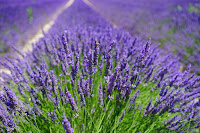Will we ever see cool
weather again?
As the heat
of summer peaks, I dream of those crisp fall evenings, sitting on the back deck
as the sun begins to tuck behind the western sky, and I look out over the
garden beds all tucked in and ready for the coming winter. In my hand is a steaming mug of home-grown
tea, made from the dried leaves and buds of some of the season’s most beautiful
floral displays. With a little know-how
and pre-planning, growing your own tea garden can enable you to mix up just the
right balance of flavors to suit your taste and is something that can be
harvested and enjoyed year-round. Some
of the tastiest, and easiest, herbs to grow for tea are:
 |
| Lavender |
Mint (Mentha sp.) (Leaves) There are a number of mint
varieties to choose from, each providing a unique flavor to brewed tea. Spearmint makes a soothing tea, while
peppermint makes a sweeter tea. A visit
to a local nursery will likely present you with choices like apple mint,
chocolate mint, and orange mint. A very
hardy, prolific plant, mint can quickly take over surrounding garden and
landscape areas. To keep this eager
spreader under control, try growing it in containers or confining it to a bed
with metal or plastic edging. Cold mint tea can be oh so refreshing during
these hot months, while now is the time to also harvest and dry the leaves to
be brewed up for a simple, yet delicious, hot tea as cooler temperatures make
their way to the valley.
Calendula: (petals) A member of the daisy
family, these beautiful yellow and orange flowers add long-lasting color to any
flower bed or container. Their frost
tolerance and somewhat cold hardy nature, as
well as their propensity to draw aphids away from other garden plants make them
great companion plants for many of those well-loved vegetables growing nearby. Simply pour hot water over the dried flowers
and let steep to your desired flavor intensity.
Lemon balm ((Melissa officinalis): (Leaves) Adding a lovely, gentle
lemon flavor, lemon balm is an easy-to-grow perennial, that tolerates full sun
to partial shade and produces delicate white, pale yellow, or pink
flowers. Though, if you are interested
in controlling this prolific plant, pruning to ensure that it does not set and drop
seed is key. Combined with other dried
ingredients, including oat straw, rose hip, orange peel, and lavender, a cup of
lemon balm tea can lift the mood on a cloudy, rainy fall day.
 |
| Chamomile |
For educational purposes only. This information has not been evaluated by the Food and Drug Administration.
Click on the following active links for more information and helpful resources about these and a multitude of other herbs excellent for cultivating a tasty tea garden, and cultivation, propagation, harvesting, and preservation.
